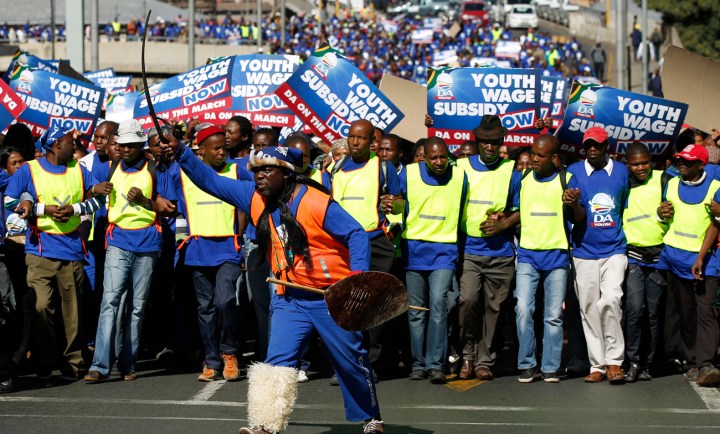Politics, South Africa
Analysis: DA vs Cosatu – any victors?

Now that the dust has settled in Braamfontein and the blue tide has retreated back over the bridge, we wonder what exactly the point of all of that was. Who won? The DA’s march to the vicinity of Cosatu House says a lot about just how dysfunctional our politics have become. It’s also a sign that things can’t continue like this. By SIPHO HLONGWANE.
The tide of blue-shirted protesters led by the Democratic Alliance Youth had begun their march over the bridge in “town” – just around the corner from the ANC headquarters at Beyers Naude Square. They came over Queen Elizabeth Street and attempted to march up De Korte St and Jorissen St to reach Cosatu House, four blocks away. They never made it all the way. A wave of red-clad protesters blocked them off completely. When the march attempted to proceed further north, they were once again stopped.
Things got so tense that the driver in the police nyala leading the DA march let off a flash-bang to prevent the Cosatu line from advancing. Rock throwing between the two groups came and went, the majority of the projectiles raining down on the blue shirts.
As the two lines stood against each other, I ran around the Boston City Campus to get from one group to the other without risking a brick on the head. On each side, I asked them why they were there.
The answer in the DA crowd varied. I was mostly told that Cosatu had set its dogs on the DA, and then disappeared so as not to have to take responsibility for the goings-on. “We obtained permission from the police to be here and these thugs won’t stop us,” one blue-shirt roared at me. When it was clear that the police weren’t going to stop the red-shirts from throwing rocks, some of the blues began shouting: “The ANC’s police!”
Over on the other side, more people were smiling. Outside Cosatu House, the air was almost festive. Down at the De Beer St end of things (where the stand-off was) the stick-waving red shirts had named their protest Operation Protect Cosatu House. That name wasn’t chosen by mistake. There is a strong emotional identity to Cosatu’s shiny new building.
In 1987, the location of the organisation at the time was bombed by the apartheid police. The idea that Cosatu House needed “protecting” would stir up those emotions among the faithful. To a lesser extent, the “protect” rhetoric also harks back to the Shell House Massacre, where ANC security guards shot and killed 19 Inkatha Freedom Party marchers. To the red side, this was a proper turf war.
It was very clear, listening to what either side had to say, that the idea of a frank exchange of ideas was out of the question. This was about brute force. Either the police would gas and shoot their way up the street, allowing the blue march to go on its way, or the red line would hold its ground by throwing rocks.
Speaking to Daily Maverick after the event, Khaya Xaba, the media liaison officer for the Young Communist League (one of the tenants at Cosatu House) said the march was clearly not about the disputed youth wage subsidy, but about political point scoring.
“Cosatu is not a public service institution and has no legal obligation to deliver on government policy. They should have marched to Luthuli House or the Union Buildings. When we have our own issues with government policy we take the complaint to the right door,” Xaba said.
“The reason for the march was to score political points and to disrespect. Because the DA advances the interests of capitalists, they think they can just march anywhere.”
The DA marched to Cosatu House because, since the minister of finance Pravin Gordhan announced the youth wage subsidy two years ago, the idea has been sitting at the National Economic Development and Labour Council, where the party believes Cosatu has consistently blocked the subsidy’s implementation to protect the vested interests of its member unions.
The leader of the DA Youth, Makashule Gana, said he was disappointed with how everything turned out. “The march began well and was meant to be peaceful. We didn’t mean to provoke anyone. We wanted to raise our issues peacefully. Unfortunately, Cosatu had other ideas,” he said.
Gana said he didn’t believe the day was a complete waste of time because the march would have demonstrated to the unemployed youth around the country that the DA Youth weren’t marching for themselves, but for all unemployed youth. He also expressed hope that they would find a way forward.
Xaba expressed a similar sentiment, saying: “If they [the DA] want to talk, we are more than happy to sit down and have them convince us. We do not believe that a youth wage subsidy is the answer. But this march will not convince us of that.”
The most immediate effect of this march will be the hardening of opinions on either side. Shortly after the DA had retreated back over the Nelson Mandela Bridge, its leaders addressed the crowd and declared the day to have been like the march of 16 June 1976. Over on the other side, Cosatu and communist leaders declared Operation Protect Cosatu House a roaring success.
Undoubtedly, those who support the DA among the public will be absolutely outraged by the violence. Those who support Cosatu, the SACP and the socialist bent of the unions will have taken enormous umbrage to the DA’s insolence.
It is easy to feel that this action only served to get some people injured, and only deepened the stalemate.
However, Cosatu and the SACP would do well to note that the DA’s caricatured voter base of white, middle-class people stayed home on Tuesday. The people who took the day off to march were mostly black. They came from townships too, not leafy suburbs.
These are people for whom the status quo in Gauteng is no longer the answer. The black people in the livery of the traditionally white party ought to send one message to Cosatu and its alliance partners – we might still struggle to talk to each other instead of speaking past each other, but the way things are now is not good enough. The ruling party better hear them. DA
Read more:
- DA Youth vs Cosatu – youth wage bill battle lines are drawn up, sharply in Daily Maverick.
Photo: South Africa’s main opposition party Democratic Alliance (DA) supporters take part in a march in Johannesburg May 15, 2012. The march by South Africa’s main opposition party on the headquarters of leading union federation COSATU descended into chaos on Tuesday, with police firing tear gas to disperse crowds of rock-throwing protesters. About 1,000 members of the opposition Democratic Alliance marched through downtown Johannesburg in support of a government plan to subsidize the wages of young people in a bid to ease chronic unemployment among the unskilled youth.The group was met by angry COSATU members who blocked the streets, sparking a violent confrontation that had to be broken up by police. REUTERS/Siphiwe Sibeko.







 Become an Insider
Become an Insider